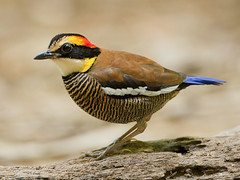| Pittidae - Passeriformes. |
Superfamilia - Pittoidea
|
Slideshow courtesy The Friends Of Worldbirds © all rights reserved
|
Photo by Michael Gillam © all rights reserved
| |
 |  | |
| World No |
Common Name
|
Scientific Name
|
Status
| Taxon |
| 3968 | Eared Pitta | Anthocincla phayrei | Least Concern | TSN: 711470 |
| 3969 | Blue-naped Pitta | Hydrornis nipalensis | Least Concern | TSN: 562238 |
| 3970 | Blue-rumped Pitta | Hydrornis soror | Least Concern | TSN: 562245 |
| 3971 | Rusty-naped Pitta | Hydrornis oatesi | Least Concern | TSN: 562240 |
| 3972 | Schneider's Pitta | Hydrornis schneideri | Vulnerable | TSN: 562243 |
| 3973 | Giant Pitta | Hydrornis caerulea | Near Threatened | TSN: 562224 |
| 3974 | Blue Pitta | Pitta cyanea | Least Concern | TSN: 562225 |
| 3975 | Javan Banded Pitta | Hydrornis guajana | Least Concern | TSN: 711668 - |
| Malayan banded pitta | Hydrornis irena | Near Threatened | TSN: 711669 | |
| Bornean banded pitta | Hydrornis schwaneri | Least Concern | TSN: 711671 | |
| 3976 | Bar-bellied Pitta | Pitta elliotii | Least Concern | TSN: 562228 |
| 3977 | Gurney's Pitta | Pitta gurneyi | Endangered | TSN: 562232 |
| 3978 | Blue-headed Pitta | Pitta baudii | Vulnerable | TSN: 562222 |
| 3979 | Hooded Pitta | Pitta sordida | Least Concern | TSN: 562244 - |
| 3980 | Ivory-breasted Pitta | Pitta maxima | Least Concern | TSN: 562235 |
| 3981 | Superb Pitta | Pitta superba | Endangered | TSN: 562247 |
| 3982 | Azure-breasted Pitta | Pitta steerii | Vulnerable | TSN: 562246 |
| 3983 | Whiskered Pitta | Pitta kochi | Least Concern | TSN: 562234 |
| Sulawesi Pitta | Pitta celebensis | No Data | TSN: 711675 | |
| 3984 | Red-bellied Pitta | Pitta erythrogaster | Least Concern | NR |
| Papuan Pitta | Pitta macklotii | No data | NR | |
| 3985 | Sula Pitta | Pitta dohertyi | Near Threatened | TSN: 711678 |
| 3986 | Blue-banded Pitta | Pitta arcuata | Least Concern | TSN: 711471 |
| 3987 | Garnet Pitta | Pitta granatina | Near Threatened | TSN: 711699 |
| 3988 | Black-crowned Pitta | Pitta venusta | Vulnerable | TSN: 562248 |
| 3989 | African Pitta | Pitta angolensis | Least concern | TSN: 562220 |
| 3990 | Green-breasted Pitta | Pitta reichenowi | Least concern | TSN: 562242 |
| 3991 | Indian Pitta | Pitta brachyura | Least concern | TSN: 562223 |
| 3992 | Fairy Pitta | Pitta nympha | Vulnerable | TSN: 562239 |
| 3993 | Blue-winged Pitta | Pitta moluccensis | Least concern | TSN: 562237 |
| 3994 | Mangrove Pitta | Pitta megarhyncha | Near Threatened | TSN: 562236 |
| 3995 | Elegant Pitta | Pitta elegans | Least concern | TSN: 711721 |
| 3996 | Rainbow Pitta | Pitta iris | Least concern | TSN: 562233 |
| 3997 | Noisy Pitta | Pitta versicolor | Least concern | TSN: 562249 |
| 3998 | Black-faced Pitta | Pitta anerythra | Least concern | TSN: 562219 |
| Black-and-crimson Pitta | Pitta ussheri | Near Threatened | TSN: 711700 |

